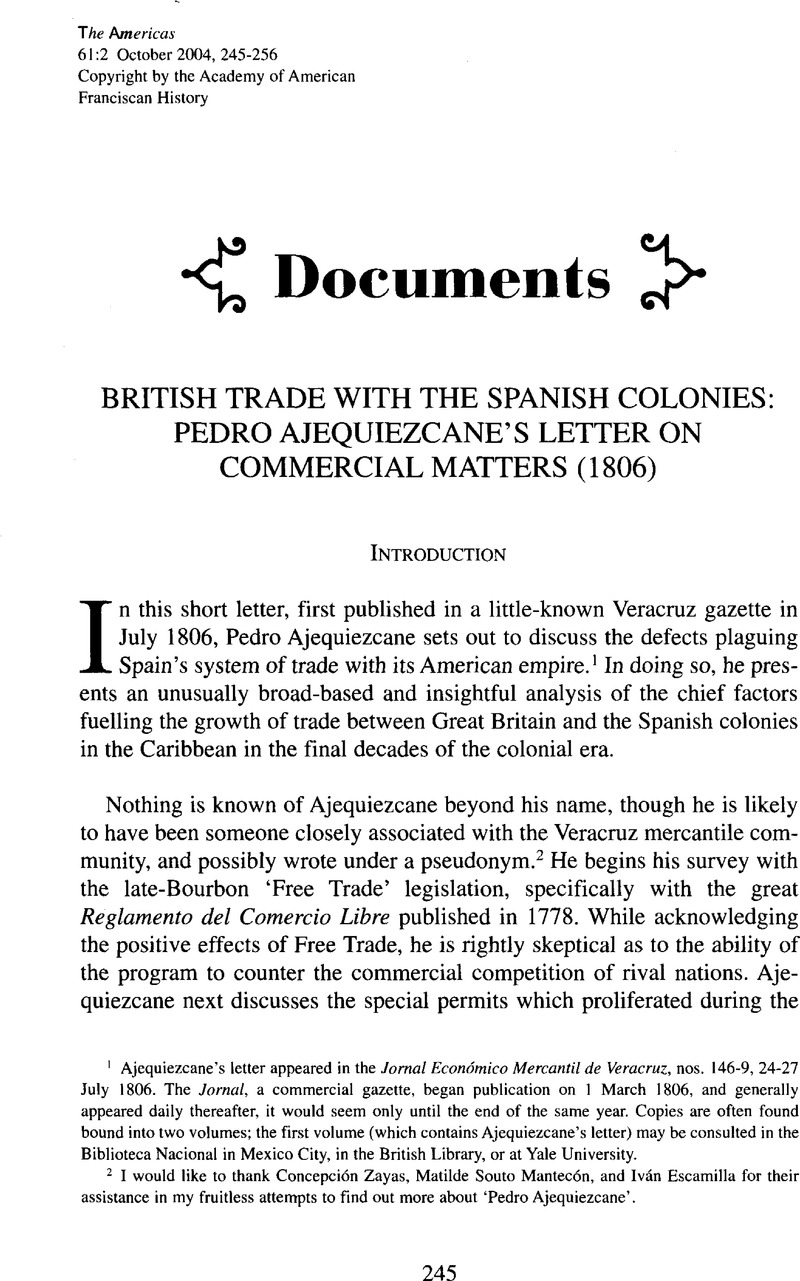Article contents
British Trade with the Spanish Colonies: Pedro Ajequiezcane's Letter on Commercial Matters (1806)
Published online by Cambridge University Press: 11 December 2015
Abstract

- Type
- Documents
- Information
- Copyright
- Copyright © Academy of American Franciscan History 2004
References
1 Ajequiezcane's letter appeared in the Jornal Económico Mercantil de Veracruz, nos. 146-9, 24-27 July 1806. The Jornal, a commercial gazette, began publication on 1 March 1806, and generally appeared daily thereafter, it would seem only until the end of the same year. Copies are often found bound into two volumes; the first volume (which contains Ajequiezcane's letter) may be consulted in the Biblioteca Nacional in Mexico City, in the British Library, or at Yale University.
2 I would like to thank Concepción Zayas, Matilde Souto Mantecón, and Iván Escamilla for their assistance in my fruitless attempts to find out more about ‘Pedro Ajequiezcane’.
3 King, James Ferguson, “Evolution of the Free Slave Trade Principle in Spanish Colonial Administration,” Hispanic American Historical Review 22:1 (Feb. 1942), pp. 34–56, still offers an accessible guide.CrossRefGoogle Scholar
4 For illicit trade generated by the free slave trade in a particular region, see McFarlane, Anthony, Colombia before Independence. Economy, Society, and Politics under Bourbon Rule (Cambridge: Cambridge University Press, 1993), pp. 157–59.CrossRefGoogle Scholar
5 The most detailed account to date of the ‘Licensed Trade’ is that of Armytage, Frances, The Free Port System in the British West Indies. A Study in Commercial Policy, 1766–1822 (London: Longmans, Green and Co., 1953), see esp. p. 95 et seq.Google Scholar
6 A fuller description of the trade was given by the colonial governor and writer on economic themes Antonio Narváez, but his text remained unpublished until the 1960s; see “Discurso del Mariscal de Campo … D. Antonio Narváez y la Torre” (30 Jun. 1805) in Ortiz, Sergio Elias (ed.) Escritos de dos economistas coloniales: Don Antonio de Narváez y la Torre y Don José Ignacio de Pombo (Bogotá: Banco de la República, 1965), pp. 67–120,Google Scholar esp. pp. 76–9, 113–20; also in Revista de Indias 91–2 (Jan.-Jun. 1963), pp. 281–316. A contemporary description by a French observer is that of Depons, François Joseph, Travels in South America, during the years 1801, 1802, 1803, and 1804, 2 vols. (1807; facsimile ed., New York: AMS Press, 1970), vol. 2, pp. 55–58.Google Scholar
7 The literature on neutral trade is extensive; probably the most useful single work bearing on the subject is de la Tabla Ducasse, Javier Ortiz, Comercio exterior de Veracruz, 1778–1821: Crisis de dependencia (Seville: Escuela de Estudios Hispano-Americanos, 1978).Google Scholar
8 This question, with the other points discussed throughout this introduction, is addressed in my study in progress titled British Trade with the Spanish Colonies, 1763–1808.
9 On the Hope contract see, e.g., Buist, Marten G., At Spes Non Fracta: Hope and Co., 1770–1815: Merchant Bankers and Diplomats at Work (The Hague: Martinus Nijhoff, 1974), esp. pp. 284–355.Google Scholar
- 1
- Cited by




